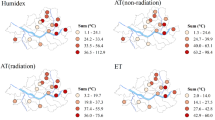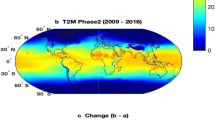Abstract
Heatwaves are often driven by subtropical persistent highs and quasi-stationary Rossby waves along with regional factors such as soil moisture. Both temperature and humidity variability play an important role in the regional heatwave patterns. Studies have differentiated the dry and moist heatwave-related extremes both in terms of their driving mechanism and in their impact on human health. With the observed increase in the intensity, frequency and duration of heatwaves in recent decades, the impact-based forecasting and monitoring (IBF) of heatwaves has assumed significance. Current operational IBF indices, especially over the Indian region are empirical and do not necessarily consider the modal dynamics or their role in the impact of dry and moist heat-related discomfort. In this study, based on two large-scale intraseasonal modes of summer temperature variability, the driving mechanisms of dry and moist heat extremes over the Indian region are identified. The regional scale impact identified based on the Heat Index is driven by these two large-scale modes. The first mode represents the conditions conducive for the formation of the dry heat extremes. The second mode represents the regional circulation pattern that supports the moisture inflow towards the coastal states. This inflow combined with the modal temperature pattern drives the moist heat extremes over India. Based on the location of the principal components of these modes in the phase space, the heat-related health risk associated with the dominant modes is assessed. Warnings for different phases of dry and moist heat extremes occurring over the Indian region are also proposed for operational use.













Similar content being viewed by others
Data availability
All the input datasets used for the analysis are freely available as mentioned in Section 2. Any computed data/ codes used to generate the plots will be made available on request.
References
Ambrizzi T, Hoskins BJ (1997) Stationary rossby-wave propagation in a baroclinic atmosphere. Q J R Meteorol Soc 123:919–928. https://doi.org/10.1002/qj.49712354007
Buzan JR, Huber M (2020) Moist Heat Stress on a Hotter Earth. Annu Rev Earth Planet Sci 48:623–655. https://doi.org/10.1146/annurev-earth-053018-060100
DaSH SK, Dey S, Pop S et al (2017) Comparative study of heat indices in India based on observed and model simulated data. Curr World Environ 12(3):530–546
Dash SK, Kjellstrom T (2011) Workplace heat stress in the context of rising temperature in India. Curr Sci 101:496–503
de Freitas CR, Grigorieva EA (2015) A comprehensive catalogue and classification of human thermal climate indices. Int J Biometeorol 59:109–120. https://doi.org/10.1007/s00484-014-0819-3
Ebi KL, Capon A, Berry P et al (2021) Hot weather and heat extremes: health risks. Lancet 398:698–708. https://doi.org/10.1016/S0140-6736(21)01208-3
Freychet N, Hegerl GC, Lord NS et al (2022) Robust increase in population exposure to heat stress with increasing global warming. Environ Res Lett 17:64049. https://doi.org/10.1088/1748-9326/ac71b9
Guleria S, Gupta AK (2018) Heat wave in India documentation of state of Telangana and Odisha (2016) National Institute of Dis aster Management, New Delhi. https://nidm.gov.in/PDF/pubs/heat_wave_18.pdf. Accessed 1 Jul 2022
Ha KJ, Seo YW, Yeo JH, Timmermann A, Chung ES, Franzke CLE, Chan JCL, Yeh SW, Ting M (2022) Dynamics and characteristics of dry and moist heatwaves over East Asia. npj Clim Atmos Sci 5(1):1–11. https://doi.org/10.1038/s41612-022-00272-4
IPCC (2013) Climate change 2013: the physical science basis. contribution of working Group I to the fifth assessment report of the intergovernmental panel on climate change. In: Stocker TF, Qin D, Plattner G-K, Tignor M, Allen SK, Boschung J, Nauels A, Xia Y, Bex V, Midgley PM (eds.) Cambridge University Press, Cambridge, United Kingdom and New York, NY, USA, pp 1535
IPCC (2021) Summary for policymakers. In: Climate change 2021: the physical science basis. contribution of working group i to the sixth assessment report of the intergovernmental panel on climate change. In: Masson-Delmotte V, Zhai P, Pirani A, Connors SL, Péan C, Berger S, Caud N, Chen Y, Goldfarb L, Gomis MI, Huang M, Leitzell K, Lonnoy E, Matthews JBR, Maycock TK, Waterfield T, Yelekçi O, Yu R, Zhou B (eds)
Ivanovich C, Anderson W, Horton R et al (2022) The Influence of Intraseasonal Oscillations on Humid Heat in the Persian Gulf and South Asia. J Clim 35:4309–4329. https://doi.org/10.1175/JCLI-D-21-0488.1
Justine J, Monteiro JM, Shah H, Rao N (2023) The diurnal variation of wet bulb temperatures and exceedance of physiological thresholds relevant to human health in South Asia. Commun Earth Environ 4:244. https://doi.org/10.1038/s43247-023-00897-0
Kanamitsu M, Ebisuzaki W, Woollen J et al (2002) NCEP–DOE AMIP-II Reanalysis (R-2). Bull Am Meteorol Soc 83:1631–1644. https://doi.org/10.1175/BAMS-83-11-1631
Kenyon J, Hegerl GC (2008) Influence of Modes of Climate Variability on Global Temperature Extremes. J Clim 21:3872–3889. https://doi.org/10.1175/2008JCLI2125.1
Kornhuber K, Coumou D, Vogel E et al (2020) Amplified Rossby waves enhance risk of concurrent heatwaves in major breadbasket regions. Nat Clim Chang 10:48–53. https://doi.org/10.1038/s41558-019-0637-z
Koteswara Rao K, Lakshmi Kumar TV, Kulkarni A et al (2020) Projections of heat stress and associated work performance over India in response to global warming. Sci Rep 10:16675. https://doi.org/10.1038/s41598-020-73245-3
Lekshmi S, Chattopadhyay R (2022) Modes of summer temperature intraseasonal oscillations and heatwaves over the Indian region. Environ Res Clim 1:025009. https://doi.org/10.1088/2752-5295/ac9fe7
Mandal R, Joseph S, Sahai AK, et al (2019) Real time extended range prediction of heat waves over India. Sci Rep 1–11. https://doi.org/10.1038/s41598-019-45430-6
Mazdiyasni O, Aghakouchak A, Davis SJ et al (2017) Increasing probability of mortality during Indian heat waves. Sci Adv 3(6):1–6
Mishra V, Ambika AK, Asoka A et al (2020) Moist heat stress extremes in India enhanced by irrigation. Nat Geosci 13:722–728. https://doi.org/10.1038/s41561-020-00650-8
Murari KK, Ghosh S, Patwardhan A et al (2015) Intensification of future severe heat waves in India and their effect on heat stress and mortality. Reg Environ Chang 15:569–579. https://doi.org/10.1007/s10113-014-0660-6
Nairn JR, Fawcett RJB (2015) The Excess Heat Factor: A Metric for Heatwave Intensity and Its Use in Classifying Heatwave Severity. Int J Environ Res Public Health 12:227–253. https://doi.org/10.3390/ijerph120100227
Narkhede N, Chattopadhyay R, Lekshmi S et al (2022) An empirical model-based framework for operational monitoring and prediction of heatwaves based on temperature data. Model Earth Syst Environ. https://doi.org/10.1007/s40808-022-01450-2
Naskar PR, Pattanaik DR (2023) Observed changes in summer thermal discomfort over Indian region during 1990–2020. J Earth Syst Sci 132:36. https://doi.org/10.1007/s12040-023-02056-7
Pai DS, Nair S (2013) Long term climatology and trends of heat waves over India during the recent 50 years (1961-2010). MAUSAM 64:585–604
Pai D, Sridhar L, Rajeevan M et al (2014) Development of a new high spatial resolution (0.25° × 0.25°) long period (1901–2010) daily gridded rainfall data set over India and its comparison with existing data sets over the region. Mausam 65:1–18. https://doi.org/10.54302/mausam.v65i1.851
Pai DS, Srivastava AK, Nair SA (2017) Heat and Cold Waves Over India. In: Rajeevan MN, Nayak S (eds) Observed Climate Variability and Change over the Indian Region. Springer Singapore, Singapore, pp 51–71
Perkins SE (2015) A review on the scientific understanding of heatwaves-Their measurement, driving mechanisms, and changes at the global scale. Atmos Res 164–165:242–267. https://doi.org/10.1016/j.atmosres.2015.05.014
Perkins SE, Alexander LV (2013) On the Measurement of Heat Waves. J Clim 26:4500–4517. https://doi.org/10.1175/JCLI-D-12-00383.1
Rani SI, Arulalan T, George JP et al (2021) IMDAA: High-Resolution Satellite-Era Reanalysis for the Indian Monsoon Region. J Clim 34:5109–5133. https://doi.org/10.1175/JCLI-D-20-0412.1
Ratnam JV, Behera SK, Ratna SB et al (2016) Anat Indian Heatwaves Sci Rep 6:24395. https://doi.org/10.1038/srep24395
Raymond C, Singh D, Horton RM (2017) Spatiotemporal Patterns and Synoptics of Extreme Wet-Bulb Temperature in the Contiguous United States. J Geophys Res Atmos 122:13,108-113,124. https://doi.org/10.1002/2017JD027140
Raymond C, Matthews T, Horton RM (2020) The emergence of heat and humidity too severe for human tolerance. Sci Adv 6:eaaw1838. https://doi.org/10.1126/sciadv.aaw1838
Raymond C, Matthews T, Horton RM et al (2021) On the Controlling Factors for Globally Extreme Humid Heat. Geophys Res Lett 48:e2021GL096082. https://doi.org/10.1029/2021GL096082
Rogers CDW, Ting M, Li C et al (2021) Recent Increases in Exposure to Extreme Humid-Heat Events Disproportionately Affect Populated Regions. Geophys Res Lett 48:e2021GL094183. https://doi.org/10.1029/2021GL094183
Rohini P, Rajeevan M, Srivastava AK (2016) On the Variability and Increasing Trends of Heat Waves over India. Sci Rep 6:26153. https://doi.org/10.1038/srep26153
Rothfusz LP (1990) The heat index equation (or, more than you ever wanted to know about heat index)(National Oceanic and Atmospheric Administration. National Weather Service, Office of Meteorology, Fort Worth, TX)
Roxy MK, Ritika K, Terray P et al (2015) Drying of Indian subcontinent by rapid Indian Ocean warming and a weakening land-sea thermal gradient. Nat Commun 6:7423. https://doi.org/10.1038/ncomms8423
Seneviratne SI, Lüthi D, Litschi M, Schär C (2006) Land–atmosphere coupling and climate change in Europe. Nature 443:205–209. https://doi.org/10.1038/nature05095
Sherwood SC, Huber M (2010) An adaptability limit to climate change due to heat stress. Proc Natl Acad Sci 107:9552–9555. https://doi.org/10.1073/pnas.0913352107
Sherwood SC (2018) Journal of Geophysical Research : Atmospheres How Important Is Humidity in Heat Stress ?. J Geophys Res : Atmos. 808–810. https://doi.org/10.1029/2018JD028969
Sinha A (2023) In Maharashtra heatstroke deaths, the critical factor of humidity. Indian Express. https://indianexpress.com/article/explained/explained-climate/heatstroke-deaths-kharghar-mumbai-why-humidity-explained-8560541/. Accessed 18 Apr 2024
Srivastava AK, Rajeevan M, Kshirsagar SR (2009) Development of a high resolution daily gridded temperature data set (1969–2005) for the Indian region. Atmos Sci Lett 10:249–254. https://doi.org/10.1002/asl.232
Srivastava A, Mohapatra M, Kumar N (2022) Hot weather hazard analysis over India. Sci Rep 12:19768. https://doi.org/10.1038/s41598-022-24065-0
Steadman RG (1979) The Assessment of Sultriness. Part I: A Temperature-Humidity Index Based on Human Physiology and Clothing Science. J Appl Meteorol Climatol 18:861–873. https://doi.org/10.1175/1520-0450(1979)018%3c0861:TAOSPI%3e2.0.CO;2
Taylor N, Kondo N, Kenney WL (2008) The physiology of acute heat exposure, with implications for human performance in the heat. In: Taylor NAS, Groeller H (eds) Physiological bases of human performance during work and exercise. 1st edn. Edinburgh: Elsevier, pp 341–358
Vecellio DJ, Tony Wolf S, Cottle RM, Larry Kenney W (2022) Evaluating the 35C wet-bulb temperature adaptability threshold for young, healthy subjects (PSU HEAT Project). J Appl Physiol 132:340–345. https://doi.org/10.1152/japplphysiol.00738.2021
WHO (2015) Heatwaves and health: guidance on warning-system development, WMO-No. 1142. World Meteorological Organization, Geneva Switzerland (https://www.who.int/publications/m/item/heatwaves-and-health--guidance-on-warning-system-development)
Acknowledgements
LS acknowledge the research fellowship support from MRFP Project, Ministry of Earth Sciences (MoES), Govt. of India. Authors acknowledge, Head CRS (IMD) for the support. Research support from Indian Institute of Tropical Meteorology (IITM), an autonomous institute under MoES, and India Meteorological Department (IMD) is acknowledged. All the computations and plots are carried out using the NCL-NCAR subroutines and Python packages.
Funding
The authors have not disclosed any funding.
Author information
Authors and Affiliations
Corresponding author
Ethics declarations
Conflict of interest
The authors declare no competing interests.
Additional information
Publisher's Note
Springer Nature remains neutral with regard to jurisdictional claims in published maps and institutional affiliations.
Supplementary Information
Below is the link to the electronic supplementary material.
Rights and permissions
Springer Nature or its licensor (e.g. a society or other partner) holds exclusive rights to this article under a publishing agreement with the author(s) or other rightsholder(s); author self-archiving of the accepted manuscript version of this article is solely governed by the terms of such publishing agreement and applicable law.
About this article
Cite this article
S, L., Chattopadhyay, R. & Pai, D.S. Attribution of subseasonal temperature modes as the drivers of dry and moist heat discomfort for the heat hazard monitoring over the Indian region. Clim Dyn (2024). https://doi.org/10.1007/s00382-024-07236-9
Received:
Accepted:
Published:
DOI: https://doi.org/10.1007/s00382-024-07236-9




